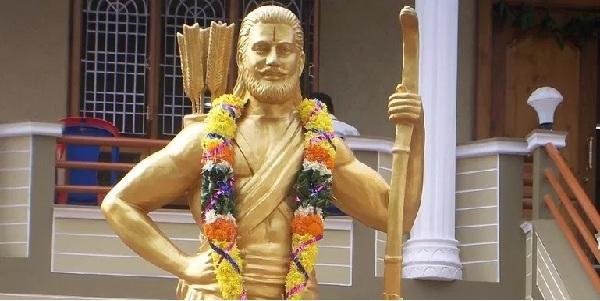
Today marks 125th birth anniversary of Alluri Sitarama Raju, one of India’s revolutionary heroes whose guerilla tactics struck terror in the hearts of the British during colonialism. Let us bow our heads in the memory of such fearless heroes who did not get their due from recorded history.
Born on July 4, 1897, Seetharama Raju is revered across Andhra Pradesh, Telangana, Odisha and Karnataka as “Manyam Veerudu” or the “Hero of the Jungle”. He is a household name in these states. Unfortunately, our history books have missed identifying his greatness. He was known to threaten the British with his audacious exploits and lightning strikes against the British and that rattled the authorities during the time, turning him into a much-revered, larger-than-life hero in these states.
Alluri, a born rebel, became a sanyasi at the age of 18. He is famously remembered for leading the Rampa rebellion in 1922-24 in the Visakhapatnam-Godavari agency area of the then Madras Presidency. He was then in his early twenties. After sending chills down the spine of the British, the fierce revolutionary laid down his life for the freedom of the motherland in 1924, at the young age of 27 years.
Born in a humble middle-class family, Alluri Sitarama Raju’s schooling was disrupted following the untimely demise of his father. Thereafter, the spiritual quest of the teenage Sitarama Raju took him on a pilgrimage to various parts of the country including Nasik, Gangotri and Chittagong (now in Bangladesh).
While undertaking these long journeys, he could see and was moved by the deprived socio-economic conditions of his fellow countrymen, particularly the tribals, under colonial rule. His travels also opened his eyes to the savage exploitation of Indians, particularly, tribals and the oppressed.
Fired by intense patriotism and a passion to free the nation from the clutches of the British, he opposed the exploitation of tribals by rulers in the wake of the Madras Forest Act, which had laid severe curbs on their movement in the forest area and prevented them from carrying out their traditional agricultural practice of Podu cultivation.
He is also credited with galvanising tribals to fight against the injustices of the British. His life is epitomised in the words of Babasaheb Ambedkar who famously said — “Life should be great rather than long”. Sitarama Raju made Adivasi areas of the Visakhapatnam and Godavari districts his home and began to work for the education and empowerment of tribal communities whose life was a picture of abject poverty. Moreover, these tribal communities faced constant harassment at the hands of the British police, forest and revenue officials.
Slowly but surely, he began preparing the ground for a direct fight against the British authorities, who had infringed upon the livelihood and traditions of Adivasis. Angered by the atrocities of the British against tribals, farmers and others, the ‘Manyam Veerudu’ built a strong team of followers to lead the historic Rampa revolt. The bravery and exploits of Sitarama Raju during the Rampa rebellion have, ever since, become part of the folklore in Andhra Pradesh and adjoining states.
His deep understanding of the forest terrain and skillful use of tribal war tactics made him a highly successful guerrilla warrior who struck fear in the hearts of the British forces. He led a series of daring attacks on the police stations. Speed and precision were distinctive features of his strikes.
It is said that all these attacks ended in a unique fashion with a letter signed by Alluri Sitarama Raju himself, giving details of the raid in the station diary. In contrast to the merciless attitude of the police forces controlled by the British, Sitarama Raju is said to have once spared the life of a native police officer who was part of a team sent to capture him, admonishing him for siding with the oppressor rather than standing with the oppressed.
For close to two years, Sitarama Raju led one of the most intense uprisings against the British in India. Shaken by these attacks, the British called in a large contingent, the special Malabar force, to halt the rampaging Sitarama Raju and his loyal band of followers. Finally, after shining as one of the brightest stars in the galaxy of Indian freedom heroes, Sitarama Raju died battling for India’s Independence on May 7, 1924.
Interestingly, this also coincides with the Centre’s “Azadi Ka Amrit Mahotsav” celebrations, commemorating the 75th year of India’s Independence.











